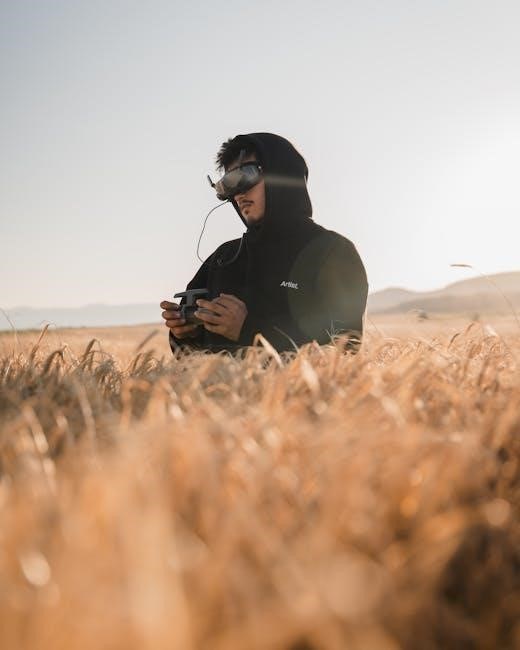Welcome to the Sky Rider Drone manual, your comprehensive guide to understanding and operating your drone safely and effectively. This manual covers essential safety, features, and troubleshooting tips to ensure optimal performance and user experience. Whether you’re a seasoned pilot or a first-time user, this guide provides detailed instructions to help you make the most of your Sky Rider Drone.
Overview of the Sky Rider Drone
The Sky Rider Drone is a versatile and advanced quadcopter designed for both hobbyists and professionals. Equipped with a Wi-Fi camera, GPS navigation, and robust flight modes, it offers an exceptional flying experience. Its foldable design and brushless motors ensure durability and portability. The drone supports HD video recording and real-time transmission, making it ideal for aerial photography and videography. With features like altitude hold and one-touch takeoff, it caters to users of all skill levels. The Sky Rider Drone also includes safety features and comprehensive instructions to ensure smooth and safe operation.
Importance of the Sky Rider Drone Manual
The Sky Rider Drone manual is essential for safe and effective operation. It provides detailed instructions for assembly, setup, and flight preparation, ensuring users understand key features and safety protocols. The manual includes troubleshooting guides, maintenance tips, and legal considerations, helping users avoid common issues and extend the drone’s lifespan. By following the manual, users can optimize performance, prevent accidents, and comply with regulations. It serves as a invaluable resource for both new and experienced pilots, offering comprehensive guidance to enhance the overall flying experience.

Safety Instructions
The Sky Rider Drone manual emphasizes essential safety protocols to ensure safe operation. It outlines critical precautions, warnings, and emergency procedures to prevent accidents and injuries. Always follow these guidelines to protect yourself and others while operating the drone.
General Safety Precautions
Always read and follow the instructions carefully before operating the Sky Rider Drone. Ensure all components are properly assembled and free from damage. Avoid flying near people, animals, or obstacles. Never operate the drone in bad weather or low visibility. Keep the drone away from water and flammable materials. Follow local regulations and avoid restricted airspace. Ensure the battery is fully charged and properly secured. Never touch the propellers while the drone is powered on. Keep children away during operation. Regularly inspect the drone for wear and tear. Failure to comply with these precautions may result in accidents or damage.
Handling the Drone with Care
Handle the Sky Rider Drone with care to maintain its performance and longevity. Always use both hands to lift and carry the drone to avoid accidental damage. Keep the drone away from children and pets when not in use. Store the drone in a dry, cool place, away from direct sunlight. Clean the drone with a soft cloth and avoid using harsh chemicals. Regularly inspect the propellers and frame for damage. Never force components together, as this may cause breakage. Store the drone in its original packaging or a protective case when not in use. Proper handling ensures safe and reliable operation.
Safety Tips for First-Time Users
Welcome to the Sky Rider Drone! For first-time users, ensure a safe and enjoyable experience by following these essential tips. Always read the manual thoroughly before your first flight. Understand the remote controller functions and practice in an open, obstacle-free area. Keep the drone away from people, animals, and fragile objects. Avoid flying near airports, power lines, or in bad weather. Ensure the drone is fully charged and all components are securely attached. Familiarize yourself with local drone regulations and flying restrictions. Never fly the drone near flammable materials or in enclosed spaces. Start with short flights to build confidence and skill. Always keep the drone in your line of sight. Happy flying!

Product Features and Specifications
The Sky Rider Drone is equipped with advanced features like Wi-Fi camera, GPS navigation, and brushless motors for smooth performance. Its foldable design ensures portability, while durable construction enhances reliability.
Key Features of the Sky Rider Drone
The Sky Rider Drone is equipped with a high-definition Wi-Fi camera for capturing stunning photos and videos. It features GPS navigation for precise tracking and stable flight. The foldable design allows for easy portability, while the brushless motors ensure durability and smooth operation. The remote controller provides intuitive controls for seamless maneuverability. Additional features include multiple flight modes, such as altitude hold and follow-me mode, enhancing user experience. The drone also includes a long-lasting battery for extended flight sessions. These features make the Sky Rider Drone an ideal choice for both recreational and professional use, offering a blend of performance and convenience.
Technical Specifications
The Sky Rider Drone features a lightweight yet durable frame, weighing approximately 1.5 pounds. It operates on a 7.4V 1200mAh Li-Po battery, offering up to 12 minutes of flight time. The drone has a maximum speed of 25 mph and a range of 300 meters. Equipped with a 1080p HD camera, it supports FPV (First-Person View) through Wi-Fi connectivity. The brushless motors ensure quieter and more efficient flights. The GPS system enhances stability and navigation, enabling features like return-to-home and waypoint tracking. These specifications make the Sky Rider Drone a reliable and advanced choice for enthusiasts and professionals alike.
Accessories Included
The Sky Rider Drone comes with a range of essential accessories to enhance your flying experience. These include a compact remote controller with intuitive controls, a high-capacity battery for extended flight times, and a charger to keep your drone powered. Additional propellers and a set of propeller guards are provided for safe operation and easy maintenance. A carrying case is also included for convenient storage and transportation. Furthermore, the package contains a detailed user manual, ensuring you have all the information needed to operate your drone effectively. These accessories make the Sky Rider Drone a complete and ready-to-fly package.

Assembly and Setup
The Sky Rider Drone assembly and setup process involves unboxing, attaching propellers, syncing the remote controller, and installing the latest firmware for optimal performance.
Unboxing the Sky Rider Drone
Unboxing your Sky Rider Drone is an exciting first step. Carefully open the package to find the quadcopter, remote controller, battery, charger, and user manual. Ensure all components are included and inspect for any visible damage. The drone is pre-assembled, but verify propellers and accessories are securely attached. Charge the battery before use, as indicated in the manual. Familiarize yourself with the drone’s design, noting features like cameras, LEDs, and control buttons. Refer to the manual for a detailed list of included items and initial setup instructions to ensure a smooth start with your Sky Rider Drone.
Assembling the Drone Components
Assembling your Sky Rider Drone is straightforward and requires careful attention to detail. Begin by attaching the propellers to the motors, ensuring they are securely fastened. Next, connect any additional accessories, such as the camera or landing gear, as outlined in the manual. Verify that all components are properly aligned and tightened. Avoid forcing parts together, as this may cause damage. Once assembled, double-check for any loose connections or misaligned parts. Finally, power on the drone to test its responsiveness. Proper assembly ensures safe and optimal performance, so take your time and follow the instructions carefully.
Setting Up the Remote Controller
Setting up the remote controller for your Sky Rider Drone is a crucial step to ensure smooth operation. Insert the batteries into the remote, making sure they are fully charged before use. Turn on the drone and the remote controller simultaneously to establish a connection. Follow the manual’s binding process, which may involve pressing specific buttons or sticks to sync the devices. Calibrate the joysticks and buttons according to the instructions provided. Test the remote’s responsiveness by moving the sticks gently. Proper setup ensures precise control and a safe flying experience. Refer to the manual for detailed calibration steps if needed.
Installing Software and Firmware
Installing the latest software and firmware is essential for optimal performance of your Sky Rider Drone. Download the software from the official website or through the Sky Rider GPS app. Connect the drone to your computer using a USB cable and follow the on-screen instructions to update the firmware. Ensure the drone is fully charged during the process. Once installed, restart the drone and remote controller to apply the updates. Regular updates enhance functionality, improve stability, and add new features. Always use authorized sources to avoid compatibility issues. For guidance, refer to the manual or manufacturer’s support page.

First Flight Preparations
Ensure all components are assembled and functioning properly. Conduct a thorough pre-flight check, calibrate the drone, and familiarize yourself with the remote controller. Follow safety guidelines.
Pre-Flight Checks
Before each flight, ensure the Sky Rider Drone is ready for operation. Check the battery level and charge if necessary. Inspect propellers for damage or debris and replace if worn. Verify GPS functionality and ensure the remote controller is synced. Review weather conditions to avoid flying in strong winds or rain. Format the SD card to ensure sufficient storage. Perform a quick systems check using the Sky Rider GPS App to confirm all components are functioning. Always follow these steps to ensure a safe and successful flight experience with your Sky Rider Drone.
Understanding the Remote Controller
The remote controller is essential for operating the Sky Rider Drone. Familiarize yourself with its layout, including the joysticks for throttle, yaw, pitch, and roll. The takeoff/landing button simplifies initial and final maneuvers. Use the mode switch to toggle between flight settings. Ensure the controller is fully charged and synced with the drone before flight. Refer to the manual for detailed functionality of each button and joystick to maximize control and performance during flights. Proper understanding of the remote controller enhances safety and flying precision.
Calibration Process
Calibrating your Sky Rider Drone ensures accurate performance and stability. Place the drone on a flat, level surface and power it on. Use the remote controller to initiate the calibration process, following the LED indicators. The drone will automatically adjust its sensors and gyroscopes. Complete calibration by following the remote’s prompts. Ensure calibration is done in an open area, away from magnetic interference. Repeat the process if you update the firmware or experience flight instability. Proper calibration is crucial for reliable operation and optimal flight experiences.
Takeoff and Landing Procedures
To initiate takeoff, ensure the drone is on a flat, stable surface and the surrounding area is clear of obstacles. Press and hold the Take Off/Landing button on the remote controller until the drone lifts off and hovers steadily. For landing, press the same button, and the drone will descend slowly to its starting position. Ensure the landing area is clear and avoid abrupt movements during descent. Once landed, power off the drone and inspect for any damage. Follow these steps carefully to ensure smooth and safe takeoff and landing operations every time.

Operating the Drone
Explore the Sky Rider Drone’s flight modes, capture stunning photos, and navigate with GPS. Master the remote controller for smooth operations and optimal performance.
Basic Flight Modes
The Sky Rider Drone offers multiple basic flight modes to enhance your flying experience. GPS Mode provides stable hovering and position holding, ideal for beginners. Altitude Hold Mode maintains a set height, simplifying camera operation. Headless Mode allows the drone to move in the same direction as the remote, making it easier to control. Sport Mode increases agility for advanced maneuvers. These modes ensure versatile operation, catering to both novice and experienced pilots. Always consult the manual for specific instructions on switching and using these modes effectively. Proper mode selection is key to safe and enjoyable flights.
Using the Camera
The Sky Rider Drone features a high-quality camera for capturing stunning photos and videos. To use the camera, ensure the drone is stabilized and properly calibrated. Access camera settings via the remote controller or the Sky Rider GPS App. Toggle between photo and video modes using the designated buttons. Adjust settings like brightness and contrast for optimal results. For storage, insert an SD card into the drone’s slot. Capture smooth footage by enabling stabilization mode. Always ensure the drone is hovering steadily before taking photos or videos. Refer to the manual for troubleshooting camera-related issues. Follow these steps to make the most of your aerial photography experience.
GPS Navigation
The Sky Rider Drone is equipped with advanced GPS navigation, enabling precise flight control and positioning. This feature enhances stability, allowing the drone to hold its position and altitude automatically. To activate GPS, ensure the drone is in an open area with clear satellite visibility. Use the remote controller or the Sky Rider GPS App to access navigation modes, such as Return-to-Home and Waypoint Navigation. The drone will automatically return to its takeoff point if the signal is lost or the battery is low. For accurate performance, calibrate the GPS before each flight. Refer to the manual for detailed calibration steps and troubleshooting tips.
Advanced Flight Features
The Sky Rider Drone offers advanced flight features designed to enhance your piloting experience; These include Follow Me mode, where the drone tracks your movement, and Orbit mode, allowing it to circle a selected point. Waypoint Navigation enables you to plot a custom flight path using the Sky Rider GPS App. Additionally, the drone supports Gesture Control, allowing for hands-free commands. For experienced pilots, Sport Mode unlocks higher speeds and agility. These features combine to provide a versatile and dynamic flying experience, catering to both recreational and professional use. Refer to the manual for detailed instructions on activating and using these modes.

Troubleshooting Common Issues
From connectivity problems to flight instability, this section helps resolve common issues with your Sky Rider Drone. Refer to the manual for solutions and prevention tips.
Common Problems and Solutions
One common issue is the drone not turning on, often due to battery drainage. Ensure the battery is fully charged and properly connected. If the drone doesn’t respond to the remote, reset the controller by turning it off, waiting 10 seconds, and restarting. For connectivity problems, check that both the drone and remote are on the same frequency. If the camera fails to record, format the memory card and ensure it’s compatible. GPS issues may occur in areas with poor signal; restart the drone and fly in an open space. Regularly update firmware to resolve software glitches.
Understanding Error Codes
Error codes on the Sky Rider Drone indicate specific issues, such as hardware malfunctions or software glitches. Codes like E001 often relate to battery errors, while E002 may signal motor problems. Refer to the manual for a detailed list of codes and their meanings. If an error occurs, power off the drone, restart it, and check for firmware updates. Some codes require recalibration or resetting the device. Always consult the troubleshooting section for step-by-step solutions. Keeping the firmware updated can prevent many error-related issues. Use the manual’s guide to diagnose and resolve problems efficiently, ensuring smooth operation of your Sky Rider Drone.
Recovery Procedures
In case of system failure or malfunction, follow these recovery steps. First, power off the drone and restart it. Ensure the firmware is up-to-date, as outdated software can cause issues. If the drone fails to respond, perform a factory reset via the remote controller or Sky Rider GPS App. For severe cases, refer to the manual’s troubleshooting guide or contact technical support. Always check for error codes and address them before resuming flight. Regularly updating firmware and performing routine checks can prevent recovery situations and ensure smooth operation of your Sky Rider Drone.
Resetting the Drone
To reset the Sky Rider Drone, power it off and press the reset button located at the bottom for 5-10 seconds. This restores default settings and clears temporary issues. For software-related problems, use the Sky Rider GPS App to perform a factory reset. Ensure the drone is fully charged before initiating the reset process. If issues persist, contact technical support or refer to the manual for additional guidance. Regular firmware updates and resets can help maintain optimal performance and resolve software glitches effectively. Always follow the manual’s instructions for a successful reset procedure.

Maintenance and Care
Regular maintenance ensures optimal performance and longevity. Clean the drone with a soft cloth, check propellers for wear, and store batteries in a cool, dry place. Avoid extreme temperatures and moisture exposure to prevent damage. Follow the manual’s guidelines for routine checks and proper storage to maintain your Sky Rider Drone in excellent condition.
Routine Maintenance Checks
Regular maintenance is crucial for ensuring your Sky Rider Drone operates smoothly. Start by inspecting the propellers for damage or wear; replace them immediately if necessary. Clean the drone’s body and camera lens with a soft cloth to remove dirt and debris. Check the battery terminals for corrosion and ensure they are securely connected. Additionally, verify that all screws and components are tightened properly. Perform these checks before and after each flight to prevent issues and extend the lifespan of your drone. Following these steps will help maintain optimal performance and reliability.
Cleaning the Drone
Regular cleaning is essential to maintain your Sky Rider Drone’s performance and longevity. Use a soft, dry cloth to wipe down the drone’s body, removing dirt, dust, or debris. Avoid using liquids or harsh chemicals, as they may damage the electronics or components. Gently clean the camera lens with a microfiber cloth to ensure clear footage. For stubborn dirt, lightly dampen the cloth with water, but avoid moisture near electrical parts. After cleaning, allow the drone to air dry before storing or flying. Regular cleaning prevents malfunctions and keeps your drone in optimal condition for every flight.
Battery Care and Charging
To ensure optimal performance and longevity, proper care and charging of your Sky Rider Drone’s battery are crucial. Always use the original charger provided, and avoid overcharging, as this can damage the battery. Charge the battery in a cool, dry place, away from direct sunlight. Store the battery at 50% charge if not in use for extended periods. Avoid extreme temperatures, as they can degrade battery health. Before first use, calibrate the battery by fully discharging it and then recharging it. Never use third-party chargers or tamper with the battery, as this can cause malfunctions or safety risks.
Storage and Transportation
Store your Sky Rider Drone in a protective case to prevent damage from dust, moisture, or physical impact. Ensure all components, including propellers and accessories, are securely packed. Avoid exposing the drone to extreme temperatures or humidity. Before storing, clean the drone thoroughly and remove any debris. For transportation, use a sturdy, padded case to safeguard against shocks and scratches. Always ensure the battery is stored separately at 50% charge to maintain its health. Regularly inspect the drone and accessories for damage before and after transportation to ensure everything is in optimal condition for the next use.

Legal and Regulatory Considerations
Understand local drone laws, FAA regulations, and privacy guidelines to ensure safe and lawful operation. Registration and adherence to no-fly zones are essential for compliance and accountability.
Drone Registration Requirements
Registering your Sky Rider Drone is essential to comply with federal regulations. In the U.S., the FAA requires drones weighing over 0.55 lbs to be registered. Visit the FAA website, create an account, and provide your personal details along with your drone’s make and model. Once registered, you’ll receive a unique ID to affix on your drone. Failure to register can result in penalties. Ensure compliance with local aviation authority rules in your country to avoid legal issues. This step ensures safe and responsible drone operation, protecting both you and others. Always carry your registration proof when flying.
Flight Restrictions and No-Fly Zones
Adhering to flight restrictions and no-fly zones is crucial for safe and legal drone operation. Federal regulations prohibit flying near airports, national parks, military bases, and other sensitive areas. Use the Sky Rider GPS app to identify restricted zones and ensure compliance. Always check local aviation authority rules before flying, as restrictions vary by region. Violating these regulations can result in legal consequences. Stay informed and plan your flights responsibly to avoid prohibited areas. This ensures a safe experience for both you and others. Familiarize yourself with no-fly zones to maintain compliance and enjoy hassle-free flying.
Privacy Laws and Guidelines
Respecting privacy is essential when operating the Sky Rider Drone. Always avoid capturing sensitive areas such as private property, individuals without consent, or restricted zones. Familiarize yourself with local privacy laws, as they vary by region. Violating these guidelines can lead to legal consequences. Ensure you adhere to ethical flying practices and respect others’ rights to privacy. This includes avoiding overhead flights near residential areas or public gatherings without proper authorization. Stay informed about specific regulations in your area to maintain compliance and promote responsible drone usage. Privacy laws are in place to protect everyone, so fly responsibly and with respect for others.
Insurance and Liability
Understanding insurance and liability is crucial when operating the Sky Rider Drone. Ensure you have adequate coverage to protect against accidental damage or third-party claims. Liability insurance can help cover costs if the drone causes injury or property damage. Always verify local regulations regarding mandatory insurance requirements. Additionally, understand your responsibility as the operator to avoid reckless behavior that could lead to legal consequences. Proper insurance not only protects your investment but also ensures compliance with legal standards. Familiarize yourself with your policy’s terms and conditions to avoid gaps in coverage. Flying responsibly minimizes risks and ensures a safe experience for everyone involved.

Frequently Asked Questions
Explore common queries about the Sky Rider Drone, including setup, operation, and troubleshooting. This section addresses user concerns and provides quick solutions for optimal drone performance.
General FAQs
Q: Where can I find the Sky Rider Drone manual?
A: The manual is available for download in PDF format on the official Sky Rider website or authorized retailer sites.
Q: How do I assemble the drone?
A: Assembly instructions are detailed in the manual, ensuring a quick and safe setup process.
Q: What are the basic steps to start flying?
A: Charge the battery, calibrate the drone, and ensure all components are securely attached before takeoff.
Q: Why isn’t the drone connecting to the remote?
A: Restart both the drone and remote, ensure batteries are charged, and check for interference from other devices.
Q: Is there a warranty for the Sky Rider Drone?
A: Yes, warranty details are provided in the manual or on the manufacturer’s official website.
Technical Support
For any technical issues or inquiries, contact Sky Rider’s dedicated support team via email or phone, available on their official website. Visit the support page for detailed assistance. The website also offers a comprehensive FAQ section and downloadable resources. Additionally, users can access live chat for immediate help. For warranty claims or repair requests, submit a ticket through the support portal. Ensure to register your drone for faster service. Community forums are also available for peer-to-peer troubleshooting and advice. Regular software updates are provided to enhance performance and resolve issues.
Warranty Information
Your Sky Rider Drone is backed by a limited warranty covering manufacturing defects for a specified period. Visit the official website to register your drone and activate warranty benefits. The warranty includes repair or replacement of defective parts, excluding damage caused by misuse or accidents. For warranty claims, contact customer support or visit the support page. Ensure to retain your purchase receipt and registration confirmation. Extended warranty options may be available for purchase. Refer to the warranty terms and conditions for detailed coverage and exclusions.